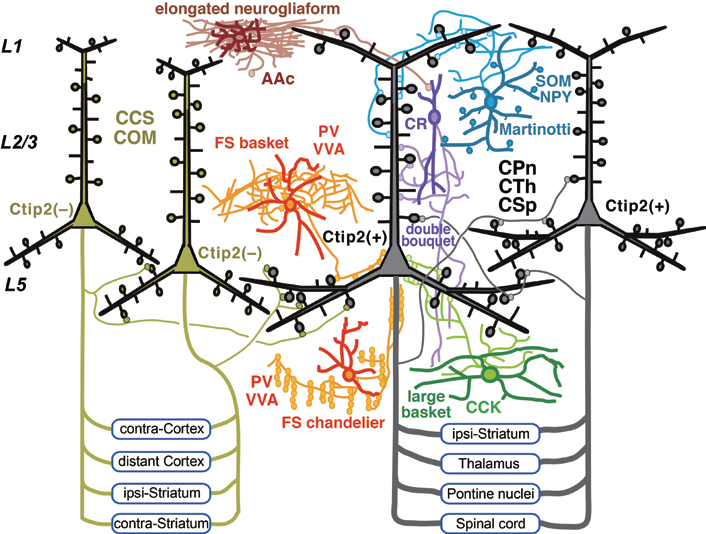Yasuo Kawaguchi (National Institute for Physiological Sciences)

“Distinct cortical subnetworks differentially route output from the frontal cortex”
A prominent feature of neocortical pyramidal cells is their diverse projections to various brain areas. Since individual cortical areas have different sets of extracortical targets, circuit organization is likely specialized in different cortical areas. However, the local synaptic connectivity of cortical neurons have been investigated mainly in the primary sensory areas. We are interested in projection-specific subnetworks, and their GABAergic regulation in the rat frontal cortex. The frontal cortex has notable functional linkages with the basal ganglia and cerebellum. Layer 5 pyramidal cells in frontal cortex project to the striatum (cortico-basal-ganglia pathway) and pontine nuclei (a relay in the cortico-cerebellar pathway). GABAergic neurons in the cortex are also morphologically, biochemically, and physiologically diverse, and preferentially innervate specific surface domains of postsynaptic neurons, including somatic, axonal, and dendritic compartments. However, little is known about whether GABAergic neuron subtypes selectively innervate glutamatergic pyramidal neurons based on their subcortical projections. To better understand the neocortical local circuit, it will be informative to characterize the synaptic connectivity among pyramidal cell subnetworks providing output to specific extracortical targets, and to identify patterns of GABAergic innervation of these networks. To this end, we have so far identified several projection neuron subtypes and found that their connectivity within layer 5 of the rat frontal cortex depends, in part, on their extracortical projections to subcortical targets, such as the basal ganglia and brainstem. More recently, we are characterizing selective GABAergic input to pyramidal neurons based on their participation in these anatomically defined cortical subnetworks. Our hope is that this new knowledge will provide insights into the function of the frontal cortex, as well as identify changes in cellular and circuit function that contribute to neurological and psychiatric disease.
Recent Publications
1. Otsuka T, Kawaguchi Y (2013) Common excitatory synaptic inputs to electrically connected cortical fast-spiking cell networks. J Neurophysiol 110: 795–806.
2. Ueta Y, Hirai Y, Otsuka T, Kawaguchi Y (2013) Direction- and distance-dependent interareal connectivity of pyramidal cell subpopulations in the rat frontal cortex. Front Neural Circuits
7:164
3. Morita K, Kawaguchi Y (2015) Computing reward prediction error: an integrated account of cortical timing and basal-ganglia pathways for appetitive and aversive learning. Eur J Neurosci 42: 2003–2021
Posted:2016/03/10

